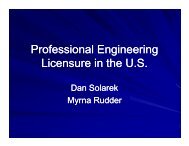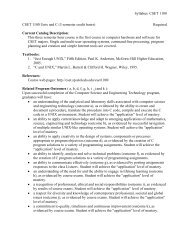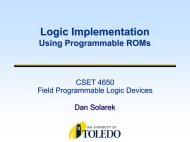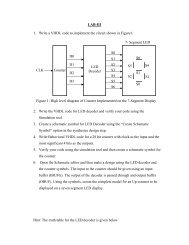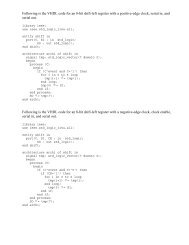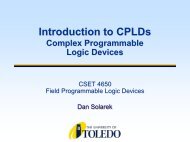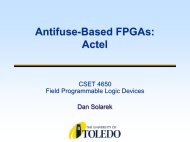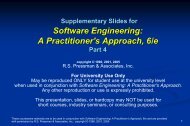Programmable Logic and Application Specific Integrated Circuits
Programmable Logic and Application Specific Integrated Circuits
Programmable Logic and Application Specific Integrated Circuits
Create successful ePaper yourself
Turn your PDF publications into a flip-book with our unique Google optimized e-Paper software.
c) Hierarchical PLD Example: Altera<br />
The Altera Multiple Array MatriX (MAX) architecture is quite different from those<br />
discussed previously in this chapter. This architecture represents a hierarchical arrangement of<br />
Erasable <strong>Programmable</strong> <strong>Logic</strong> Devices (EPLDs) using a two-dimensional array structure. The<br />
design provides multiple level logic, uses a programmable routing structure, <strong>and</strong> is user reprogrammable<br />
based on EPROM or EEPROM technology. Thus, although these devices are<br />
marketed by Altera as EPLDs, they clearly meet the criteria to be called FPGAs in the context of<br />
this chapter.<br />
The MAX 5000 series <strong>and</strong> second generation MAX 7000 series architectures consist of an<br />
array of large programmable blocks, called <strong>Logic</strong> Array Blocks (LABs). 18 19 Each LAB in the<br />
MAX 7000 family is constructed from 16 macrocells. Each macrocell in turn has a<br />
programmable-AND / fixed-OR array <strong>and</strong> a configurable register. Thus, each macrocell<br />
represents a small PLD with five programmable product terms, <strong>and</strong> it can be configured for either<br />
sequential or combinatorial operation. Complex logic functions can be constructed using multiple<br />
macrocells. In addition, the Altera LAB architecture provides both shareable <strong>and</strong> parallel<br />
exp<strong>and</strong>er product terms (“exp<strong>and</strong>ers”) that can be used to create additional product terms directly<br />
to any macrocell in the same LAB. Finally, at the top level of the design hierarchy, signals are<br />
routed between LABs by a <strong>Programmable</strong> Interconnect Array (PIA). This global routing resource<br />
connects any signal source to any destination on the chip. Figure 16 shows a portion of the MAX<br />
7000 architecture; <strong>and</strong> illustrates the <strong>Programmable</strong> Interconnect Array (PIA), <strong>Logic</strong> Array Block<br />
(LAB) with its constituent macrocells, <strong>and</strong> I/O Control (IOC) block.<br />
figure 1 from MAX 7000 data book........<br />
Figure 16. Altera MAX 7000 Internal Architecture<br />
Table 8 lists a summary of the characteristics of the first <strong>and</strong> second generation MAX 5000<br />
<strong>and</strong> MAX 7000 families. The FLEX 8000 series Altera design listed in the table departs from the<br />
earlier families in its use of SRAM programming technology. 20 This series continues Altera’s<br />
fine-grain hierarchical architecture by using 4-input look-up table <strong>Logic</strong> Elements (LEs) as the<br />
basic functional building block. LE’s are grouped into sets of eight to create LABs as in the<br />
earlier family designs; <strong>and</strong> these blocks are arranged into rows <strong>and</strong> columns. Connections<br />
between LEs are provided by horizontal <strong>and</strong> vertical FastTrack interconnect channels which span<br />
the chip. Both the <strong>Logic</strong> Elements <strong>and</strong> the FastTrack interconnects are SRAM programmed in an<br />
analogous fashion to the Xilinx technology discussed earlier. The MAX 9000 family identified in<br />
the table is a third generation Multiple Array MatriX architecture which has features of both the<br />
MAX 7000 <strong>and</strong> FLEX 7000 families. 21 It uses EEPROM non-volatile programming, <strong>and</strong> logic is<br />
28




